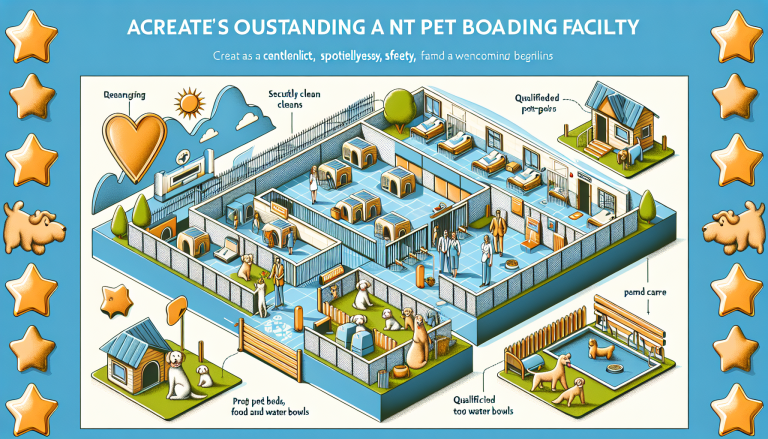So, you’re getting a new pet! How exciting! But before you bring home your furry or feathered friend, there are a few things you need to consider and prepare. From creating a safe and comfortable space for them to ensuring you have all the necessary supplies, this article will guide you through the essential steps to take before your new pet’s arrival. Whether you’re getting a cuddly kitten or a playful puppy, these tips will help you make the transition smooth and enjoyable for both you and your new companion.
Table of Contents
ToggleChoosing the Right Pet
Bringing a new pet into your home is an exciting and fulfilling experience. However, before you make this important decision, it’s crucial to thoroughly research different breeds. Each breed has its own specific needs and temperament, so it’s essential to find a pet that aligns with your lifestyle and preferences.
Take the time to understand the characteristics, exercise requirements, and grooming needs of various breeds. Consider factors such as size, energy level, and compatibility with children or other pets. Are you looking for a playful and active companion or a more laid-back and low-maintenance pet? By researching different breeds, you can make an informed choice that will ensure a harmonious and fulfilling relationship with your new furry friend.
Consider Your Lifestyle
When choosing a pet, it’s not only important to consider the breed’s characteristics but also to take your own lifestyle into account. Do you have a busy schedule or do you work from home? Are you an active individual who enjoys outdoor activities, or do you prefer a more relaxed indoor lifestyle? These questions will help guide you in finding a pet that fits seamlessly into your daily routine.
For example, if you have a hectic schedule and limited time to dedicate to exercise and training, a low-energy pet that doesn’t require daily vigorous exercise might be a better fit. On the other hand, if you lead an active lifestyle and enjoy spending time outdoors, a high-energy breed that can keep up with your activities might be the perfect match. By selecting a pet that aligns with your lifestyle, you are setting yourself and your new companion up for a successful and happy life together.
Evaluate Your Living Space
Before bringing a new pet home, it’s important to evaluate your living space to ensure it can accommodate their specific needs. Take into consideration factors such as the size of your home, whether you have a yard, and any potential restrictions or limitations. Different pets have different space requirements, so it’s crucial to choose a pet that will have enough room to move and play comfortably.
If you live in a smaller apartment or don’t have a yard, you might want to consider a smaller breed or a pet that doesn’t require as much space to roam. Conversely, if you have a larger home with a spacious yard, you may have more flexibility in the type and size of pet you can bring into your home. Remember, providing a suitable living space is essential for the well-being and happiness of your new pet.
Pet-Proofing Your Home
Just like a curious toddler, a new pet will explore their surroundings, often with their mouth. Therefore, it’s crucial to pet-proof your home to ensure their safety and prevent potential accidents or injuries. Here are a few essential steps to help you create a safe environment for your furry friend.
Remove Hazards
Start by identifying and removing any potential hazards within your home. Secure or put away any small objects that could be swallowed, such as coins, buttons, or small toys. Make sure to keep household chemicals, medications, and toxic plants out of reach. Take note of any fragile or valuable items that could be knocked over or damaged.
Secure Loose Wires and Cords
Pets, especially young ones, are naturally curious and may be drawn to electrical wires and cords. Not only can this cause damage to your electronics, but it also poses a serious risk of electrocution. Keep cords and wires out of reach or securely fastened to prevent your pet from chewing on them. Consider using cord covers or cable management solutions to keep them hidden and secure.
Store Toxic Substances Safely
Many common household items can be toxic to pets if ingested. Store cleaning products, pesticides, and other potentially harmful substances in locked cabinets or high shelves. Keep medications, vitamins, and human food out of reach as well. It’s crucial to be vigilant and ensure that your pet doesn’t have access to anything that could be harmful to their health.
Getting the Essentials
Once you have prepared your home for the arrival of your new pet, it’s time to gather the essential supplies they will need. Being well-prepared will make the transition smoother for both you and your new furry family member. Here are the key items you should have ready:
Food and Water Bowls
Invest in high-quality, durable food and water bowls that are appropriate for your pet’s size. Consider the material and design of the bowls, as some may be easier to clean or less likely to tip over. It’s also important to choose bowls that are the appropriate size for your pet to ensure they have access to fresh food and water at all times.
Bed or Crate
Providing your pet with a comfortable sleeping area is essential. Depending on your pet’s preferences and needs, you may opt for a cozy bed or a crate. Both options offer a sense of security and a designated space that is solely theirs. Consider the size and material of the bed or crate to ensure it’s suitable for your pet’s size and breed.
Toys and Chew Items
To keep your pet mentally stimulated and entertained, invest in a variety of toys and chew items. Different pets have different preferences, so it may take some trial and error to find the toys that your pet enjoys the most. Interactive toys can be especially beneficial, as they provide mental stimulation and encourage physical activity. Additionally, having appropriate chew items can help redirect your pet’s chewing behavior away from your furniture or belongings.
Preparing a Safe Space
Creating a safe space for your new pet will not only provide them with a sense of security but also help prevent accidents or destructive behavior. Designate a specific room or area in your home where your pet can retreat to when they need some downtime. Here are a few steps to set up a safe space for your pet:
Designate a Room or Area
Choose a room or area in your home that can be designated as your pet’s safe space. This could be a spare bedroom, a quiet corner of the living room, or even a cozy crate. Make sure the area is free from any potential hazards, such as dangling cords or toxic plants. Ideally, this space should be easy to monitor and easily accessible for you to check on your pet when needed.
Set Up a Comfortable Bed
Place a comfortable bed or blanket in your pet’s safe space to provide them with a cozy spot to rest and relax. Choose a bed that is appropriate for your pet’s size and breed, and consider their sleeping preferences. Some pets may prefer a soft, cushioned bed, while others might enjoy a more structured and supportive option.
Provide a Litter Box or Potty Pad
If you have a cat or a dog that will be trained to use a potty pad, make sure to set up a designated area for them to relieve themselves. For cats, provide a litter box with clean litter that is easily accessible. For dogs, use potty pads or designate a specific area outdoors where they can go. Make sure to clean the litter box or potty pad regularly to maintain a clean and hygienic environment for your pet.
Stocking Up on Supplies
Before bringing your new pet home, it’s important to stock up on the necessary supplies to ensure their well-being and comfort. Being well-prepared will help you settle into a routine more smoothly and ensure that your pet’s needs are met. Here are some essential supplies to purchase:
Food and Treats
Choose a high-quality pet food that is appropriate for your pet’s age, size, and breed. Consider any specific dietary requirements or preferences your pet may have. Stock up on enough food to last for a few weeks, to avoid any last-minute trips to the store. Additionally, select a variety of treats that can be used for training or as rewards for good behavior.
Grooming Supplies
Depending on the type of pet you have, grooming supplies will vary. For dogs, you may need brushes, combs, nail clippers, and shampoo. Cats may require a brush or comb, nail clippers, and litter box supplies. Research the specific grooming needs of your pet’s breed and make sure to have the necessary tools on hand. Regular grooming sessions will help keep your pet’s coat healthy and prevent any discomfort or skin issues.
Training Tools
If you have a new puppy or a pet that requires training, having the right tools is crucial. Invest in a secure and comfortable harness or collar, along with a leash. For puppies, consider purchasing puppy pads or a crate for potty training. Look into training treats and toys that can help reinforce positive behavior. Being equipped with the right training tools will make the training process more effective and enjoyable for both you and your pet.
Finding a Veterinarian
Finding a reputable veterinarian is essential to ensure your pet’s health and well-being. They will be your go-to resource for vaccinations, routine check-ups, and any health concerns you may have. Here are some steps to help you find and choose the right veterinarian for your pet:
Ask for Recommendations
Start by asking friends, family, or neighbors who have pets for recommendations. They can provide valuable insights into the quality of care provided by local veterinarians. Additionally, you can reach out to local animal shelters or rescue organizations for suggestions. Their staff often work closely with veterinarians and can recommend trusted professionals.
Schedule a First Visit
Once you have gathered some recommendations, schedule a first visit with the veterinarian to get a sense of their practice and establish a relationship. During this visit, observe the cleanliness and organization of the clinic, as well as the demeanor of the staff. Take note of how the veterinarian interacts with your pet and addresses any concerns or questions you may have.
Discuss Vaccinations and Preventative Care
Part of your initial visit with the veterinarian should involve discussing the necessary vaccinations and preventative care for your pet. They will provide guidance on when to schedule vaccinations, as well as flea and tick prevention, heartworm medication, and any other necessary preventive treatments. It’s important to stay up to date with these vaccinations and treatments to ensure your pet remains healthy and protected.
Creating a Routine
Establishing a routine is essential for both you and your new pet. Dogs and cats thrive on routine and predictability, as it provides them with a sense of security and stability. Here are some key elements to consider when creating a routine for your pet:
Establish Mealtimes
Set consistent mealtimes for your pet to ensure they receive the proper nutrition and maintain a healthy weight. Stick to a schedule that works for your lifestyle and ensures that your pet is fed at regular intervals. Remember to provide fresh water at all times throughout the day as well.
Set Regular Walk or Play Times
Physical exercise is crucial for the overall well-being of your pet. Dogs, in particular, require daily walks and playtime to burn off excess energy and stimulate their minds. Set aside dedicated time each day for exercise, whether it’s a walk, a game of fetch, or interactive play with toys. Cats can also benefit from play sessions, so make sure to provide them with toys and engage in playtime regularly.
Implement a Sleep Schedule
Pets, like humans, benefit from a regular sleep schedule. Establish a consistent bedtime routine that signals to your pet that it’s time to wind down and prepare for sleep. This can include activities such as a calming walk or playtime, followed by a settled-down period in their designated sleeping area. Consistency will help your pet develop healthy sleep patterns and ensure they are well-rested.
Enrolling in Training Classes
Training classes provide an excellent opportunity to bond with your pet and teach them essential skills and commands. Whether you have a puppy or an older pet, training classes can help address behavioral issues, improve obedience, and strengthen the relationship between you and your furry friend. Here’s how to approach enrolling in training classes:
Research Training Options
Research and explore different training options available in your area. Look for reputable trainers who use positive reinforcement techniques and have experience working with your pet’s breed or age group. Read reviews and ask for recommendations to ensure you choose a trainer who is knowledgeable, patient, and compassionate.
Choose a Suitable Class
Consider your pet’s age, breed, and specific needs when selecting a training class. Some classes focus on basic obedience training, while others specialize in specific areas, such as agility or socialization. Choose a class that aligns with your goals and the particular needs of your pet. Additionally, consider the class size and environment to ensure your pet will be comfortable and able to learn in that setting.
Register or Sign Up
Once you have found the right training class, register or sign up to secure your spot. Classes often have limited availability, so it’s important to book early. Take note of the schedule and any preparation requirements, such as bringing treats, vaccination records, or specific equipment. By enrolling in training classes, you are investing in your pet’s well-being and providing them with the tools they need for a happy and obedient life.
Introducing the Pet to the Family
If you have children or other pets at home, introducing your new pet to the family requires careful planning and supervision. It’s important to create a positive and controlled environment to ensure a smooth transition and avoid any potential conflicts. Here’s how to introduce your pet to the family:
Prepare Children or other Pets
Before your new pet arrives, prepare children or other pets for the upcoming change. Explain to children what to expect and how to safely interact with the new pet. Teach them how to interact gently and respectfully, and set clear rules and boundaries. For existing pets, gradually introduce them to the scent of the new pet by exchanging bedding or using pheromone diffusers. This gradual introduction can help minimize any tension or territorial behavior.
Plan a Controlled Introduction
When it’s time for the first physical meeting between your new pet and the family members, plan a controlled introduction. Keep the environment calm and quiet, and have all family members present. Use leashes or crates to ensure everyone’s safety, and monitor the interactions closely. Allow each family member to approach the new pet gradually and gently. Focus on creating positive associations and rewarding calm and friendly behavior.
Supervise Interactions
Even after the initial introduction, continue to supervise and manage interactions between your new pet and other family members. Gradually increase the amount of time they spend together, always ensuring a positive and controlled environment. Be patient and allow time for everyone to adjust to each other’s presence. Provide supervision, especially during meal times or play sessions, to prevent any potential conflicts or resource guarding behavior.
Budgeting for Pet Expenses
Owning a pet comes with financial responsibilities. Before bringing a new pet into your home, it’s essential to budget for their expenses to ensure that you can provide them with the care they need. Here are some important factors to consider:
Estimate Monthly Costs
Calculate the estimated monthly expenses for your pet, including food, treats, veterinary care, grooming, and pet insurance. Research the average costs for these items and adjust them based on your pet’s breed, size, and specific needs. Don’t forget to include other recurring costs, such as toys, bedding, and training classes. By estimating your monthly expenses, you can determine if you can comfortably provide for your pet’s needs.
Consider Emergency Vet Care
Emergency veterinary care can be costly, but it is a crucial part of owning a pet. Unexpected accidents or illnesses can occur, and having the means to cover these expenses is essential. Consider budgeting for an emergency fund specifically for your pet’s healthcare needs, so you are prepared for any unexpected situations.
Factor in Grooming and Boarding
Depending on your pet’s breed and grooming requirements, grooming services may be necessary. Research the costs of grooming in your area and factor them into your budget. Additionally, if you plan to travel or be away from home for extended periods, consider the costs of boarding or pet-sitting services. These expenses should be included in your overall budget to ensure you can provide for your pet’s well-being even when you are away.
By following these steps, you will be well-prepared for the arrival of your new pet. Remember that owning a pet is a long-term commitment, and providing them with a loving and caring environment is essential for their well-being. Enjoy the journey of welcoming a new furry family member into your home and savor the joy and companionship they will bring to your life.








